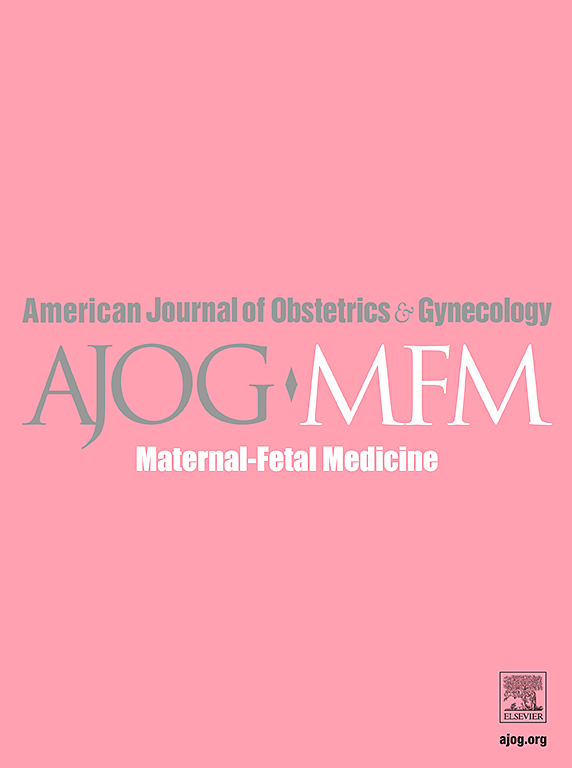减少差异的机构团队目标战略之后的重症孕产妇发病率趋势。
IF 3.1
2区 医学
Q1 OBSTETRICS & GYNECOLOGY
American Journal of Obstetrics & Gynecology Mfm
Pub Date : 2024-10-18
DOI:10.1016/j.ajogmf.2024.101529
引用次数: 0
摘要
背景:在美国,孕产妇妊娠结局,特别是发病率和死亡率方面的种族差异持续存在,因此,采取多方面的方法来减少这些差异至关重要。2020 年,我们的医疗系统致力于降低黑人患者的严重孕产妇发病率(SMM),并采取了多种战略干预措施,包括隐性偏见培训、定期报告按种族和民族分层的 SMM 综合指标、最佳实践标准化、集中努力降低出血风险以及全系统团队建设:本研究的目的是调查在集中采取干预措施以改善孕产妇总体预后,特别是黑人患者预后的这段时期内,按种族划分的 SMM 趋势:这是一项回顾性队列研究,评估了费城一家学术性城市三级护理医院的所有分娩入院情况,该医院是医疗系统的一个站点,包括五家分娩医院,时间跨度为 2019-2021 年,为期三年。从电子病历(EMR)中提取了包括患者人口统计学、临床特征和结果在内的数据。自我报告的种族被归类为 EMR 中记录的黑人与非黑人。SMM 根据 CDC 既定指标以及 Vizient 为 SMM 常见来源(包括出血、感染和栓塞)确定的附加代码进行定义。采用多变量逻辑回归模型对各年的数据进行分析,该模型包括保险类型和产科并发症指数(OB-CMI),OB-CMI 是一个加权评分系统,考虑了多种慢性疾病和产前妊娠并发症:共纳入 12,339 例分娩,其中 64.6%(N=8,012)为黑人患者。黑人患者的 OB-CMI 中位数为 3(四分位数间距 [IQR] 1-5),高于非黑人患者的 2(四分位数间距 [IQR] 1-4),P < 0.01。在研究期间,整个队列的SMM显著下降(从2019年的8.5%降至2021年的6.5%,p = 0.001),特别是黑人患者的SMM率有所下降(从2019年的8.9%降至2021年的6.6%,p = 0.005),而非黑人患者的SMM率下降不明显(从2019年的7.8%降至2021年的6.3%,p = 0.21)。调整后的模型同样显示,随着时间的推移,黑人患者的SMM风险降低(2020年与2019年调整后的几率比[aOR] = 0.81,95%置信区间[CI] 0.69-0.96;2021年与2019年调整后的几率比[aOR] 0.73,95%置信区间[CI] 0.62-0.86):这家以黑人患者为主的医院在两年时间内(2020-2021 年)致力于改善孕产妇结局的公平性,这与 SMM 的显著下降有关,尤其是在黑人患者中。这一研究结果表明,在减少 SMM 及相关差异方面,高层次、协调性和系统性的方法取得了成功。本文章由计算机程序翻译,如有差异,请以英文原文为准。
Trends in severe maternal morbidity following an institutional team goal strategy for disparity reduction
Background
Racial disparities in maternal pregnancy outcomes, specifically in morbidity and mortality, are persistent in the U.S., and a multifaceted approach to mitigating these disparate outcomes is critical. In 2020, our health system committed to reducing severe maternal morbidity (SMM) in Black patients, employing multiple strategic interventions including implicit bias training, regular reporting of a composite SMM metric stratified by race and ethnicity, standardization of best practices, focused efforts for hemorrhage risk reduction, and system-wide team building.
Objective
The goal of this study is to investigate trends in SMM by race across this period of concentrated interventions to improve maternal outcomes overall, and specifically for Black patients.
Study Design
This is a retrospective cohort study evaluating all delivery admissions at an academic, urban, tertiary-care hospital in Philadelphia—one site of a health system encompassing five delivery hospitals—over a 3-year period from 2019 to 2021. Data including patient demographics, clinical features, and outcomes were extracted from the electronic medical record (EMR). Self-reported race was categorized as Black vs non-Black as documented in the EMR. SMM was defined according to established CDC indicators as well as additional codes identified by Vizient for common sources of SMM including hemorrhage, infection, and embolism. Data were analyzed by year with a multivariable logistic regression model including insurance type and obstetric comorbidity index (OB-CMI), a weighted scoring system accounting for numerous chronic medical conditions and antepartum pregnancy complications.
Results
In total, 12,339 deliveries were included, 64.6% (N=8012) of which were to Black patients. Median OB-CMI score was higher for Black patients at 3 (interquartile range [IQR] 1–5) compared to 2 (IQR 1–4) for non-Black patients, P<.01. There was a significant decrease in SMM for the entire cohort over the study period (8.5% in 2019 to 6.5% in 2021, P=.001), driven by a decreased rate specifically among Black patients (8.9% in 2019 to 6.6% in 2021, P=.005) with a nonsignificant decrease for non-Black patients (7.8% in 2019 to 6.3% in 2021, P=.21). The adjusted model similarly demonstrated decreased risk of SMM over time for Black patients (2020 vs 2019 adjusted odds ratio [aOR] = 0.81, 95% confidence interval [CI] 0.69–0.96; 2021 vs 2019 aOR 0.73, 95% CI 0.62–0.86).
Conclusion
Dedicated efforts to improve equity in maternal outcomes over a 2-year period (2020–2021) in this hospital serving a Black patient majority were associated with a significant decline in SMM, especially among Black patients. This finding demonstrates the success of a high-level, coordinated, and systematic approach in reducing SMM and associated disparities, and is highly consequential in light of the ongoing major epidemic of racial disparities in obstetric outcomes.
求助全文
通过发布文献求助,成功后即可免费获取论文全文。
去求助
来源期刊

American Journal of Obstetrics & Gynecology Mfm
Medicine-Medicine (all)
CiteScore
7.40
自引率
3.20%
发文量
254
审稿时长
40 days
期刊介绍:
The American Journal of Obstetrics and Gynecology (AJOG) is a highly esteemed publication with two companion titles. One of these is the American Journal of Obstetrics and Gynecology Maternal-Fetal Medicine (AJOG MFM), which is dedicated to the latest research in the field of maternal-fetal medicine, specifically concerning high-risk pregnancies. The journal encompasses a wide range of topics, including:
Maternal Complications: It addresses significant studies that have the potential to change clinical practice regarding complications faced by pregnant women.
Fetal Complications: The journal covers prenatal diagnosis, ultrasound, and genetic issues related to the fetus, providing insights into the management and care of fetal health.
Prenatal Care: It discusses the best practices in prenatal care to ensure the health and well-being of both the mother and the unborn child.
Intrapartum Care: It provides guidance on the care provided during the childbirth process, which is critical for the safety of both mother and baby.
Postpartum Issues: The journal also tackles issues that arise after childbirth, focusing on the postpartum period and its implications for maternal health. AJOG MFM serves as a reliable forum for peer-reviewed research, with a preference for randomized trials and meta-analyses. The goal is to equip researchers and clinicians with the most current information and evidence-based strategies to effectively manage high-risk pregnancies and to provide the best possible care for mothers and their unborn children.
 求助内容:
求助内容: 应助结果提醒方式:
应助结果提醒方式:


